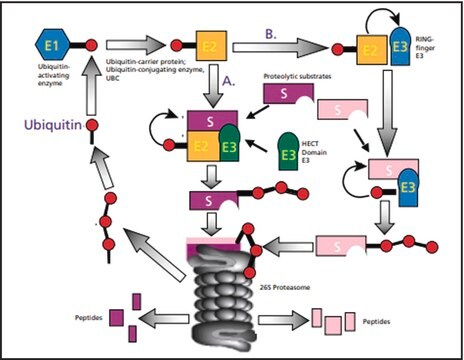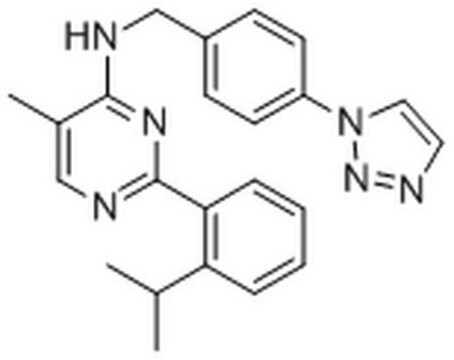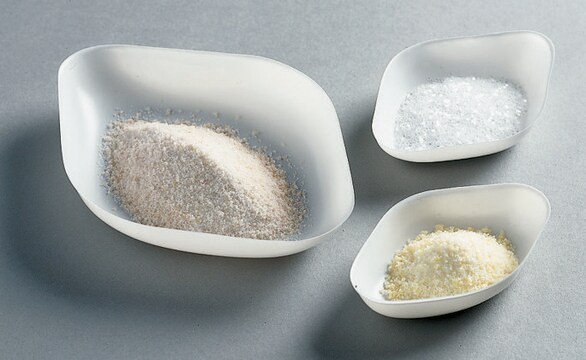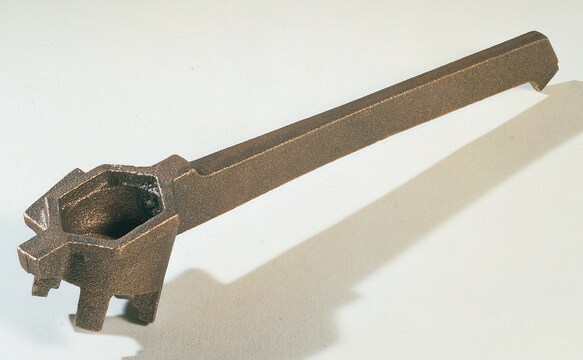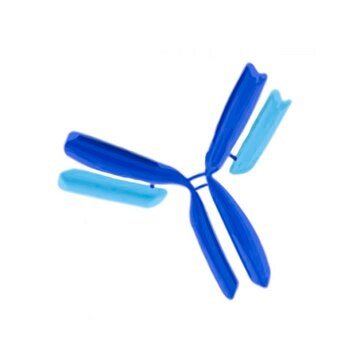17-10388
Di-Ubiquitin (Lys63-linked) Recombinant Protein
Native K63 linked Di-Ubiquitin which can be used as a substrate for proteases that cleave the isopeptide linkage between two ubiquitin molecules.
Faça loginpara ver os preços organizacionais e de contrato
About This Item
Código UNSPSC:
12352202
eCl@ss:
32160405
NACRES:
NA.52
Produtos recomendados
Nível de qualidade
Ensaio
>95% (reversed phase HPLC)
peso molecular
Mw ~17 kDa
fabricante/nome comercial
Chemicon®
Condições de expedição
dry ice
Descrição geral
ANTIBODY AVAILABLE!
Anti-Ubiquitin, Lys63-Specific, clone Apu3 (catalogue # 05-1308)
This product is a native K63 linked Di-Ubiquitin which can be used as a substrate for proteases that cleave the isopeptide linkage between two ubiquitin molecules. It can also be used to investigate mechanism of binding and recognition by proteins that contain ubiquitin-associated domains or ubiquitin-interacting motifs (UIMs).
This product is formed by chemical ligation.
Anti-Ubiquitin, Lys63-Specific, clone Apu3 (catalogue # 05-1308)
This product is a native K63 linked Di-Ubiquitin which can be used as a substrate for proteases that cleave the isopeptide linkage between two ubiquitin molecules. It can also be used to investigate mechanism of binding and recognition by proteins that contain ubiquitin-associated domains or ubiquitin-interacting motifs (UIMs).
This product is formed by chemical ligation.
Polyubiquitin chains linked through the Lys48 residue of ubiquitin are most commonly associated with proteins targeted for proteosomal degradation.
In contrast, polyubiquitin chains linked through the Lys63 residue of ubiquitin (Ub) are associated with nonproteolytic functions such as signal transduction. Lys63-linked polyUb chains connect components of NFκB signaling in a highly regulated manner, and genetic evidence indicates the involvement of Lys63-linked Ub chains in stress response and DNA repair. Research in yeast has suggested Lys63-linked Ub chains stimulate endocytosis.
In contrast, polyubiquitin chains linked through the Lys63 residue of ubiquitin (Ub) are associated with nonproteolytic functions such as signal transduction. Lys63-linked polyUb chains connect components of NFκB signaling in a highly regulated manner, and genetic evidence indicates the involvement of Lys63-linked Ub chains in stress response and DNA repair. Research in yeast has suggested Lys63-linked Ub chains stimulate endocytosis.
Aplicação
LC-MS Analysis
Mobile phase A = 1% CH3CN, 0.1% formic acid in water (MilliQ) and B = 1% water (milliQ) and 0.1% formic acid in
CH3CN. Phenomenex Kinetex C18, (2.1×50 mm, 2.6 μM); flow rate = 0.6 mL/min, runtime = 6 min, column T = 40°C.
Gradient: 5% to 95% B over 3.5 min. (See Figure 2)
Mobile phase A = 1% CH3CN, 0.1% formic acid in water (MilliQ) and B = 1% water (milliQ) and 0.1% formic acid in
CH3CN. Phenomenex Kinetex C18, (2.1×50 mm, 2.6 μM); flow rate = 0.6 mL/min, runtime = 6 min, column T = 40°C.
Gradient: 5% to 95% B over 3.5 min. (See Figure 2)
Componentes
50 µg of Di-Ubiquitin (Lys63-linked) reconstituted in 2.5 µL DMSO and 56 µL of 0.02 M TRIS, 0.25 M NaCl, pH 7.5 to a final concentration of 50 µM.
Qualidade
Western Blot Analysis:
0.5-2 μg/mL of anti-Ubiquitin, Lys63-Specific, clone Apu2 (Cat. # 05-1308) detected Lys63-linked Ubiquitin from 1 µg of Di-Ubiquitin (Lys63-linked) Recombinant Protein (Cat. # 17-10388). (See Figure 1)
0.5-2 μg/mL of anti-Ubiquitin, Lys63-Specific, clone Apu2 (Cat. # 05-1308) detected Lys63-linked Ubiquitin from 1 µg of Di-Ubiquitin (Lys63-linked) Recombinant Protein (Cat. # 17-10388). (See Figure 1)
Armazenamento e estabilidade
Store at -80°C. Avoid freeze/thaw cycles.
Informações legais
CHEMICON is a registered trademark of Merck KGaA, Darmstadt, Germany
Exoneração de responsabilidade
Unless otherwise stated in our catalog or other company documentation accompanying the product(s), our products are intended for research use only and are not to be used for any other purpose, which includes but is not limited to, unauthorized commercial uses, in vitro diagnostic uses, ex vivo or in vivo therapeutic uses or any type of consumption or application to humans or animals.
Código de classe de armazenamento
10 - Combustible liquids
Classe de risco de água (WGK)
WGK 1
Ponto de fulgor (°F)
188.6 °F - (refers to pure substance)
Ponto de fulgor (°C)
87 °C - (refers to pure substance)
Certificados de análise (COA)
Busque Certificados de análise (COA) digitando o Número do Lote do produto. Os números de lote e remessa podem ser encontrados no rótulo de um produto após a palavra “Lot” ou “Batch”.
Já possui este produto?
Encontre a documentação dos produtos que você adquiriu recentemente na biblioteca de documentos.
Nossa equipe de cientistas tem experiência em todas as áreas de pesquisa, incluindo Life Sciences, ciência de materiais, síntese química, cromatografia, química analítica e muitas outras.
Entre em contato com a assistência técnica